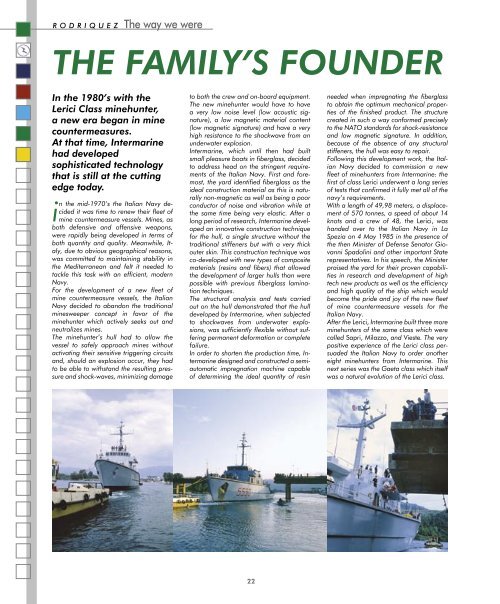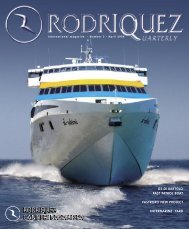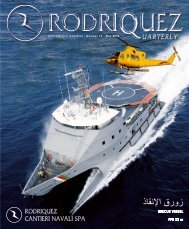Rodriquez Quarterly n. 4.pdf - RODRIQUEZ - Cantieri navali
Rodriquez Quarterly n. 4.pdf - RODRIQUEZ - Cantieri navali
Rodriquez Quarterly n. 4.pdf - RODRIQUEZ - Cantieri navali
Create successful ePaper yourself
Turn your PDF publications into a flip-book with our unique Google optimized e-Paper software.
R O D R I Q U E Z The way we were<br />
THE FAMILY’S FOUNDER<br />
In the 1980’s with the<br />
Lerici Class minehunter,<br />
a new era began in mine<br />
countermeasures.<br />
At that time, Intermarine<br />
had developed<br />
sophisticated technology<br />
that is still at the cutting<br />
edge today.<br />
in the mid-1970’s the Italian Navy decided<br />
it was time to renew their fleet of<br />
mine countermeasure vessels. Mines, as<br />
both defensive and offensive weapons,<br />
were rapidly being developed in terms of<br />
both quantity and quality. Meanwhile, Italy,<br />
due to obvious geographical reasons,<br />
was committed to maintaining stability in<br />
the Mediterranean and felt it needed to<br />
tackle this task with an efficient, modern<br />
Navy.<br />
For the development of a new fleet of<br />
mine countermeasure vessels, the Italian<br />
Navy decided to abandon the traditional<br />
minesweeper concept in favor of the<br />
minehunter which actively seeks out and<br />
neutralizes mines.<br />
The minehunter’s hull had to allow the<br />
vessel to safely approach mines without<br />
activating their sensitive triggering circuits<br />
and, should an explosion occur, they had<br />
to be able to withstand the resulting pressure<br />
and shock-waves, minimizing damage<br />
to both the crew and on-board equipment.<br />
The new minehunter would have to have<br />
a very low noise level (low acoustic signature),<br />
a low magnetic material content<br />
(low magnetic signature) and have a very<br />
high resistance to the shockwave from an<br />
underwater explosion.<br />
Intermarine, which until then had built<br />
small pleasure boats in fiberglass, decided<br />
to address head on the stringent requirements<br />
of the Italian Navy. First and foremost,<br />
the yard identified fiberglass as the<br />
ideal construction material as this is naturally<br />
non-magnetic as well as being a poor<br />
conductor of noise and vibration while at<br />
the same time being very elastic. After a<br />
long period of research, Intermarine developed<br />
an innovative construction technique<br />
for the hull, a single structure without the<br />
traditional stiffeners but with a very thick<br />
outer skin. This construction technique was<br />
co-developed with new types of composite<br />
materials (resins and fibers) that allowed<br />
the development of larger hulls than were<br />
possible with previous fiberglass lamination<br />
techniques.<br />
The structural analysis and tests carried<br />
out on the hull demonstrated that the hull<br />
developed by Intermarine, when subjected<br />
to shockwaves from underwater explosions,<br />
was sufficiently flexible without suffering<br />
permanent deformation or complete<br />
failure.<br />
In order to shorten the production time, Intermarine<br />
designed and constructed a semiautomatic<br />
impregnation machine capable<br />
of determining the ideal quantity of resin<br />
22<br />
needed when impregnating the fiberglass<br />
to obtain the optimum mechanical properties<br />
of the finished product. The structure<br />
created in such a way conformed precisely<br />
to the NATO standards for shock-resistance<br />
and low magnetic signature. In addition,<br />
because of the absence of any structural<br />
stiffeners, the hull was easy to repair.<br />
Following this development work, the Italian<br />
Navy decided to commission a new<br />
fleet of minehunters from Intermarine: the<br />
first of class Lerici underwent a long series<br />
of tests that confirmed it fully met all of the<br />
navy’s requirements.<br />
With a length of 49,98 meters, a displacement<br />
of 570 tonnes, a speed of about 14<br />
knots and a crew of 48, the Lerici, was<br />
handed over to the Italian Navy in La<br />
Spezia on 4 May 1985 in the presence of<br />
the then Minister of Defense Senator Giovanni<br />
Spadolini and other important State<br />
representatives. In his speech, the Minister<br />
praised the yard for their proven capabilities<br />
in research and development of high<br />
tech new products as well as the efficiency<br />
and high quality of the ship which would<br />
become the pride and joy of the new fleet<br />
of mine countermeasure vessels for the<br />
Italian Navy.<br />
After the Lerici, Intermarine built three more<br />
minehunters of the same class which were<br />
called Sapri, Milazzo, and Vieste. The very<br />
positive experience of the Lerici class persuaded<br />
the Italian Navy to order another<br />
eight minehunters from Intermarine. This<br />
next series was the Gaeta class which itself<br />
was a natural evolution of the Lerici class.





